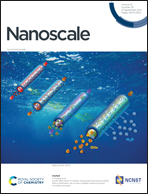Caged structural water molecules emit tunable brighter colors by topological excitation†
Abstract
Intrinsically, free water molecules are a colourless liquid. If it is colourful, why and how does it emit the bright colours? We provided direct evidence that when water was trapped into the sub-nanospace of zeolites, the structural water molecules (SWs) exhibited strong tunable photoluminescence (PL) emissions from blue to red colours with unprecedented ultra-long lifetimes up to the second scale at liquid nitrogen temperature. Further controlled experiments and combined characterizations by time-resolved steady-state and ultra-fast femtosecond (fs) transient optical spectroscopy showed that the singly adsorbed hydrated hydroxide complex {OH−·H2O} as SWs in the confined nanocavity is the true emitter centre, whose PL efficiency strongly depends on the type and stability of the SWs, which is dominated by H-bond interactions, such as the solvent effect, pH value and operating temperature. The emission of SWs exhibits the characteristic of topological excitations (TAs) due to the many-body quantum electron correlations in confined nanocavities, which differs from the local excitation of organic chromophores. Our model not only elucidates the origin of the PL of metal nanoclusters (NCs), but also provides a completely new insight to understand the nature of heterogeneous catalysis and interface bonding (or state) at the molecule level, beyond the metal-centred d band theory.



 Please wait while we load your content...
Please wait while we load your content...